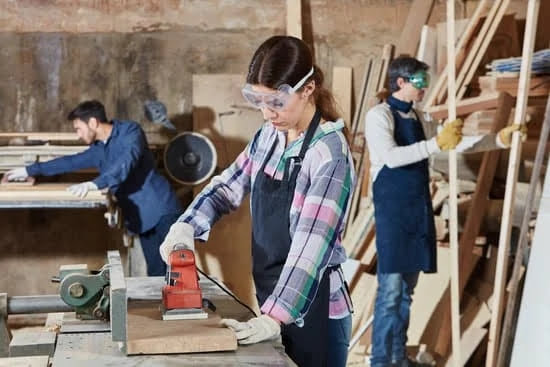Woodworking is a centuries-old craft that involves shaping and manipulating wood to create functional and artistic objects. From furniture to tools and decorative pieces, woodworking offers a unique outlet for creativity and allows individuals to express their craftsmanship through the use of natural materials.
One popular project in woodworking is making a spatula – a versatile kitchen utensil that can be customized to suit individual preferences. In this article, we will explore the world of woodworking and delve into the process of creating your very own spatula.
Woodworking as a hobby has gained significant popularity in recent years due to its numerous benefits and satisfying nature. The act of taking raw wood and transforming it into a useful or beautiful object provides a deep sense of accomplishment and fulfillment. For many, woodworking serves as an escape from the fast-paced digital world, allowing them to reconnect with tradition and work with their hands.
Furthermore, woodworking offers an opportunity for self-expression through craftsmanship. Every wooden object created carries the unique touch of its creator, reflecting their style, skill level, and personality. Whether you are a beginner or an experienced woodworker, there is always room for growth and improvement in this versatile craft.
Throughout this article, we will guide you through the process of making your own spatula using woodworking techniques. We will discuss important considerations such as choosing the right wood materials, using essential tools safely, designing your spatula for optimal functionality, troubleshooting common mistakes, ensuring maintenance for longevity, and even showcasing your finished masterpiece.
So let us dive into the exciting world of woodworking as we embark on this journey to create our very own handmade spatula – not only a functional kitchen tool but also a testament to our creativity and craftsmanship.
Understanding the Materials
Woodworking projects require careful consideration when selecting the appropriate wood for your desired object. When it comes to making a spatula, the choice of wood is particularly important as it affects both the functionality and appearance of the final product. In this section, we will explore different types of wood suitable for spatula making, considerations for wood grain and hardness, as well as sustainability and ethical sourcing of wood materials.
When selecting wood for your spatula project, it is important to choose a type of wood that is both food-safe and durable. Some common types of wood that are suitable for spatulas include cherry, walnut, maple, and beech. These woods are known for their tight grain structure, which makes them less likely to absorb liquids or food particles and makes them easier to clean.
Another factor to consider when choosing the right wood for your spatula is its hardness. Ideally, you want a wood that is relatively hard so that it can withstand the pressures and repeated use in the kitchen. Hardwoods such as oak or ash are good options in this regard. However, keep in mind that excessively hard woods may also be more difficult to work with when shaping and carving your spatula.
Additionally, it is essential to consider sustainability and ethical sourcing when selecting your wood materials. Opting for woods that are responsibly harvested helps protect forests and supports sustainable practices. Look for certifications such as FSC (Forest Stewardship Council) or PEFC (Programme for the Endorsement of Forest Certification) to ensure that the wood has been sourced from well-managed forests.
| Wood Type | Description |
|---|---|
| Cherry | A tight-grained hardwood known for its durability. |
| Walnut | A dark-colored hardwood with a rich grain pattern. |
| Maple | A light-colored wood known for its strength and resistance to wear. |
| Beech | A durable and smooth wood often used in kitchen utensils. |
By carefully considering the type of wood, its hardness, and the sustainability of its sourcing, you can ensure that your spatula is not only functional but also a responsible choice. Not only will it enhance your woodworking skills, but it will also produce a beautiful and long-lasting kitchen tool.
Tools and Equipment
Woodworking requires a variety of tools and equipment to successfully create a spatula. Whether you are a beginner or have some experience in woodworking, having the right tools is crucial for achieving the desired results. In this section, we will discuss the essential woodworking tools needed for making a spatula.
Introduction to basic hand tools
When it comes to woodworking, there are several basic hand tools that should be in every woodworker’s toolkit. These tools allow for precise and intricate work, providing more control over the shaping and smoothing process. Some of the essential hand tools for making a spatula include:
- Chisels: Chisels are used for cutting and shaping wood. They come in various sizes and shapes, allowing you to create different contours and details on your spatula.
- Saw: A backsaw or coping saw can be used to make straight or curved cuts in the wood. This tool is necessary for shaping the handle of your spatula.
- Smoothing Plane: A smoothing plane helps in leveling rough surfaces and achieving a smooth finish on your spatula.
Optional power tools
While hand tools are sufficient for most woodworking projects, using power tools can speed up the process and offer more precision in certain tasks. However, they are not necessary if you prefer traditional woodworking techniques or if you are just starting out as a woodworker. Some optional power tools that can be useful for making a spatula include:
- Router: A router can be used to add decorative edges or shapes to your spatula’s handle.
- Belt Sander: A belt sander is handy for quickly shaping or sanding larger surfaces of wood.
- Power Drill: A power drill can be used for drilling holes or creating recesses in your spatula.
Safety precautions and proper tool maintenance
When working with any woodworking tool, safety should always be a priority. Before using any tool, make sure to read and understand the manufacturer’s instructions and safety guidelines. Some general safety precautions to consider include:
- Wearing protective gear such as safety glasses, ear protection, and gloves.
- Keeping your work area clean and organized to prevent accidents.
- Regularly maintaining your tools by cleaning, sharpening, and lubricating them for optimal performance.
Remember that woodworking requires patience and practice. As you gain more experience, you may discover additional tools that suit your specific woodworking style or projects. By investing in high-quality tools and taking proper care of them, you can enjoy woodworking for years to come.
| Tool | Description |
|---|---|
| Chisels | Cutting and shaping wood |
| Saw | Straight or curved cuts in the wood |
| Smoothing Plane | Leveling rough surfaces and achieving a smooth finish on your spatula. |
Designing the Spatula
When it comes to creating a spatula through woodworking, it’s important to consider both functionality and aesthetics. A well-designed spatula not only serves its purpose effectively but also adds beauty to your kitchen utensils collection. In this section, we will discuss the factors to consider when designing a spatula and how to incorporate artistic elements and personal style into your creation.
Firstly, functionality should be at the forefront of your design considerations. Think about the length, width, and shape of the spatula head that will work best for your intended uses. If you plan on using it for flipping delicate foods like pancakes or fish fillets, a thinner and wider head would be ideal. On the other hand, if you often cook in smaller pans, a more compact head size might be appropriate.
Another important aspect is the handle grip. Consider the comfort and ergonomics of holding your spatula for extended periods of time. Some people prefer curved handles that fit naturally in their hands, while others may opt for straight handles with a thumb rest for added control. It’s all about finding what feels comfortable to you.
Once you have considered functionality, it’s time to delve into the aesthetic elements of your design. Feel free to let your imagination run wild and incorporate artistic details that reflect your personal style. You could carve intricate patterns or shapes on the spatula head or engrave meaningful motifs on the handle. This is an opportunity to make your spatula truly unique and showcase your creativity.
To ensure that you’re satisfied with your design before starting the woodworking process, it can be helpful to sketch or draft your final spatula design. This will allow you to visualize how each element fits together and make any adjustments before committing them to wood.
In summary, designing a spatula involves carefully considering its functionality as well as incorporating artistic elements that appeal to you personally. By exploring different shapes, sizes, and decorative features, you can create a spatula that not only serves its purpose but also adds beauty to your kitchen. So, let your inner artist shine through as you design your very own spatula masterpiece.
- Factors to consider when designing a spatula (e.g., length, width, handle grip).
- Incorporating artistic elements and personal style.
- Sketching or drafting the spatula design before starting the woodworking process.
Step-by-Step Guide
To craft your own spatula from start to finish, you will need to follow a step-by-step guide that outlines the various stages of the woodworking process. By following these steps, you can create a functional and beautiful spatula that showcases your woodworking skills.
- Prepare the wood: Start by selecting a suitable piece of wood for your spatula project. Make sure it is clean, dry, and free from any knots or defects. Cut the wood to the desired length and width using a saw or other cutting tools.
- Shape and sand the wood: Use a chisel or gouge to carefully shape the head of the spatula according to your design. Smooth out any rough edges or imperfections with sandpaper of gradually finer grits until you achieve a smooth surface.
- Carve the handle: Determine the desired shape and size for your spatula’s handle. Using a saw, chisel, or other carving tools, shape the handle to match your design preferences. Be sure to create a comfortable and ergonomic grip that feels good in your hand.
- Finishing techniques: Once you are satisfied with the overall shape and feel of your spatula, it’s time to apply finishing techniques for both protection and improved appearance. You can choose to stain the wood for added color or depth, apply oil for enhancing its natural beauty, or varnish for extra durability.
Remember always to wear appropriate safety gear such as goggles and gloves when working with woodworking tools. Additionally, it’s essential to maintain proper tool maintenance by cleaning them after use and ensuring they stay sharp for more precise woodworking tasks.
By following this step-by-step guide, you will be able to create your own handmade spatula through woodworking. The satisfaction that comes from seeing your creation take form is truly rewarding. Now that you have successfully completed this project, consider exploring other woodworking projects and honing your skills even further.
Troubleshooting and Common Mistakes
Dealing with Wood Splitting or Cracking
One common challenge that woodworkers may face during the spatula-making process is wood splitting or cracking. This can be frustrating, but there are some techniques that can help overcome this issue. Firstly, it is important to choose the right type of wood for your project. Certain woods, such as oak and maple, are less prone to splitting than others. Additionally, make sure that the wood you are using is properly dried and seasoned to minimize the risk of splitting.
If you do encounter splitting or cracking while working on your spatula, there are steps you can take to salvage the piece. One method is to use a strong adhesive and clamps to carefully glue the split sections back together. Be sure to apply pressure evenly and allow sufficient time for the adhesive to dry completely before continuing with the woodworking process.
Another technique involves using wooden dowels or splines to reinforce the cracked areas. By creating small holes on either side of the crack and inserting dowels or splines coated with adhesive, you can strengthen and stabilize the wood.
Fixing Mistakes in Measurements or Shaping
Mistakes in measurements or shaping are another common challenge when making a spatula woodworking project. However, there are ways to correct these errors without having to start over from scratch. If you have cut a piece of wood too short or made an incorrect angle, one option is to add material back by gluing on extra pieces of matching wood in a process known as patching. This technique allows you to extend or reshape sections as needed.
For mistakes related to shaping, such as uneven edges or angles, sanding can be a valuable tool for achieving a more desired result. Using different grits of sandpaper progressively from coarse to fine will allow you to reshape and smooth out imperfections in your spatula’s design. Remember to take your time during the sanding process, as rushing can potentially cause more damage to the wood.
Tips for Achieving a Smooth and Professional Finish
Achieving a smooth and professional finish is an essential aspect of woodworking. It not only enhances the overall appearance of your spatula but also helps protect the wood from moisture and wear over time. One important tip is to sand the wood in between each coat of finish. This will create a smoother surface by eliminating any rough spots or imperfections before applying the next layer of finish.
Another technique for achieving a professional finish is to apply multiple thin coats of your chosen finish rather than one thick coat. Thin coats are easier to control and allow sufficient drying time between applications, resulting in a smoother and more durable finish. Additionally, using a high-quality brush or foam applicator will help reduce brush marks or streaks, ensuring an even application.
Lastly, take care when choosing your finishing product. Different finishes have different properties, so consider factors such as durability, resistance to heat or chemicals, and desired appearance when selecting which type of finish will work best for your spatula project. Experimenting with different finishes on scrap pieces of wood can be helpful in determining which one suits your needs and preferences before applying it to your final piece.
By following these troubleshooting tips and avoiding common mistakes, you can overcome challenges that may arise during your woodworking journey and create beautifully crafted spatulas that are both functional and visually appealing. Remember that practice makes perfect, so don’t be discouraged if you encounter difficulties along the way – woodworking is about learning from these experiences and constantly improving your skills.
Maintenance and Care
Proper cleaning and drying techniques
To ensure the longevity of your handmade spatula, it is important to follow proper cleaning and drying techniques. After each use, gently wash the spatula with warm soapy water, using a soft sponge or cloth to remove any food residue. Avoid using harsh chemicals or abrasive scrubbers that can damage the wood.
Rinse thoroughly and dry the spatula immediately to prevent moisture from soaking into the wood, which can lead to warping or cracking. Allow the spatula to air dry completely before storing it.
Applying maintenance coatings to protect the wood
Adding a protective coating to your handmade spatula can help preserve its beauty and increase its lifespan. There are several options you can consider for coating the wood surface. One popular choice is applying food-grade mineral oil as it helps nourish the wood and prevents it from drying out.
Beeswax or a mixture of beeswax and mineral oil can also be used to create a natural sealant that enhances durability. Apply a thin layer of the chosen coating using a clean cloth, following the direction of the wood grain, and allow it to soak in for several hours or overnight before wiping off any excess.
Storage recommendations to prevent damage or warping
Proper storage is crucial in maintaining the quality of your handmade spatula. Store it in an upright position or hang it on a utensil rack, away from direct sunlight and heat sources that can cause discoloration or deformation of the wood. It is also advisable to store your spatula in an area with controlled humidity levels, as extreme changes in humidity can lead to swelling or shrinking of the wood fibers.
If you choose to store your spatulas in a drawer, make sure they are not overcrowded or compressed against other utensils, as this can result in dents or scratches on their surfaces. By following these storage recommendations, you can protect your spatula from unnecessary damage and ensure its longevity for years to come.
Maintaining and caring for your handmade spatula not only keeps it looking beautiful but also extends its lifespan, allowing you to enjoy using it in your culinary adventures for a long time. By implementing proper cleaning techniques, applying maintenance coatings, and storing the spatula correctly, you can preserve the natural beauty of the wood and protect it from potential damage. Taking these steps will ensure that your handmade spatula remains a valuable tool in your kitchen arsenal.
Showcasing Your Spatula
After putting in the time and effort to create your own spatula through woodworking, it’s time to showcase your masterpiece and embrace the pride of your craftsmanship. Showcasing your spatula not only allows you to share your work with others but also gives you a sense of accomplishment and satisfaction. Here are some tips on how to showcase your handmade spatula:
- Photographing Your Finished Spatula: Take high-quality photographs of your finished spatula to capture its beauty and craftsmanship. Find a well-lit area where the details of the wood grain and design can be clearly seen. Experiment with different angles and compositions to highlight the unique features of your spatula.
- Sharing on Social Media and Woodworking Communities: Share your finished spatula on social media platforms like Instagram or Facebook, or join online woodworking communities. These platforms provide an opportunity for you to connect with other woodworking enthusiasts, receive feedback on your work, and gain inspiration from their projects.
- Ideas for Gifting or Selling Handmade Spatulas: Consider gifting your handmade spatulas to friends, family, or even as part of a housewarming gift. Alternatively, you may want to explore selling your creations at local craft fairs or online marketplaces specializing in handmade goods. Be sure to price them appropriately based on factors such as materials used, craftsmanship quality, and any additional artistic elements incorporated into the design.
By showcasing your handmade spatula, you not only inspire others who might be interested in woodworking but also celebrate the skill and dedication that went into creating something functional yet beautiful. Enjoy sharing your work with others while embracing the pride that comes from creating a unique piece through woodworking.
Conclusion
In conclusion, woodworking offers a unique and fulfilling opportunity to create your own spatula. Throughout this article, we have explored the various aspects involved in this process, from understanding the materials to designing and crafting the spatula. By following the step-by-step guide and learning from common mistakes, you can overcome challenges and achieve a smooth and professional finish.
The joy of woodworking lies not only in the final product but also in the process itself. The satisfaction of transforming raw materials into a functional and aesthetically pleasing spatula is unparalleled. As you continue exploring woodworking projects, you will gain valuable skills and confidence in your abilities.
Furthermore, making your own spatula allows for personalization and artistic expression. You can incorporate unique design elements that reflect your style and preferences. Don’t be afraid to experiment with different wood types or try out new techniques.
Sharing your woodworking creations with others can also bring a sense of pride and accomplishment. Whether it’s capturing photos of your finished spatula or showcasing it on social media platforms or woodworking communities, these avenues allow you to connect with fellow woodworking enthusiasts and receive feedback on your craftsmanship.
Lastly, consider gifting or selling your handmade spatulas as a way to share your passion with others. A beautifully crafted wooden utensil makes for an excellent present or addition to someone’s kitchenware collection.
Frequently Asked Questions
What wood is best for a spatula?
The best wood for a spatula is typically one that is strong, durable, and heat-resistant. Hardwoods like beech, cherry, maple, or walnut are popular choices due to their natural resistance to moisture and their ability to withstand high temperatures.
These woods also have a smooth grain that makes them ideal for carving and shaping into spatulas. Additionally, they are non-toxic and do not impart any unwanted flavors to food.
What materials are used to make a spatula?
Spatulas can be made from various materials depending on their intended use and desired characteristics. Traditional spatulas are commonly made from wood or bamboo, as these materials have a natural resistance to heat and are gentle on non-stick cookware. Modern spatulas often utilize flexible silicone heads attached to metal or plastic handles.
Silicone is heat-resistant, easy to clean, and does not scratch delicate surfaces. Metal spatulas with stainless steel heads or blades are also prevalent in professional kitchens due to their sturdiness and heat-resistance.
How to make wooden utensils?
Making wooden utensils begins with selecting the right type of hardwood that is suitable for carving and has proper strength characteristics for utensil use. The wood is typically cut into a rectangular block of appropriate size for the desired utensil shape. Using specialized carving tools such as chisels, gouges, or knives, the wood is then carefully shaped into the desired utensil form.
This process involves removing excess material while creating a smooth surface and ergonomic handle design. Once carved, the wooden utensil needs to be sanded thoroughly using progressively finer grit sandpapers until the surface becomes completely smooth. Lastly, applying food-safe finishes like mineral oil or beeswax helps protect the wood from moisture absorption and gives it a polished appearance while making it safe for contact with food.

Hi everyone! I’m a woodworker and blogger, and this is my woodworking blog. In my blog, I share tips and tricks for woodworkers of all skill levels, as well as project ideas that you can try yourself.





